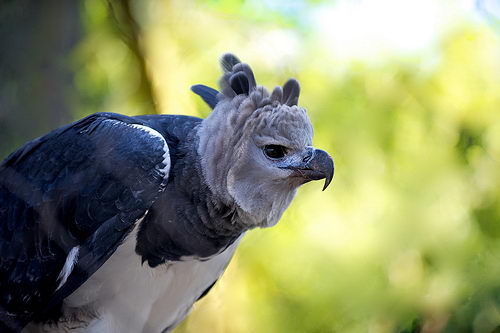I’m bringing you some of the most exciting harpy eagle facts that such as harpy eagle habitat, diet, breeding and predatory behavior. The harpy eagle (Harpia harpyja) is a bird of prey that casts a sinister shadow over the rainforests of tropical America.
These birds terrify hapless animals that forage in the shifting sunlight of the high canopy. Harpy eagle is the largest and the most powerful raptor throughout America. They belong to the family of accipitridae.
American harpy eagle typically inhabits lowland rainforests but are disappearing from much of its range due to habitat loss and it almost extirpated in Central America.
Harpy Eagle Facts
- The harpy eagle is recognized by its slate black feathers that are seen at its upper side, with the undersides are mostly white. They have a pale grey head together with the crown.
- Both male and female displays the same plumage. As in other raptors, females are larger than males.
- The harpy eagle’s tarsus measures around 13 cm (5.1 inches) in length.
- The weight of the female measures around 6 to 9 kg (13 to 20 lb), with the largest female named jezebel weighed around 12.3 kg (27 lb).
- The male weighs around 4 to 4.8 kg (8.8 to 11 lb).
- They measure around 86.5 – 107 cm (2 ft 10 in – 3 ft 6 in) in length.
- The wingspan of harpy eagle measures around 176 to 224 cm (5 ft 9 in to 7 ft 4 in).
- The length of the wing chord is up to 54 – 63 cm (1 ft 9 in to 2 ft 1 in), with the tail measuring at 37 – 42 cm (1 ft 3 in – 1 ft 5 in).
- It is fairly smaller than the philippine eagle but is still regarded as the largest specie.
- American harpy eagle takes silent flight from the nest to take on its prey.
- These eagles hunt over a territory of up to 20 sq. miles.

Image Courtesy of ptybirds.com
Distribution and Habitat
- Harpy eagle inhabits all throughout Mexico, ranging from Central America to the South America and stretching towards Argentina.
- American harpy eagle is the national bird of Panama. They are found in the extensive tropical lowland rainforests of South and Central America.
- Harpy eagles normally exist at an elevation of 900 meters (3,000 feet), with the highest elevation reaching up to 2,000 meters (6,600 feet). They seldom inhabit semi-open forest areas.

Feeding Ecology and Diet
- American harpy eagle is an active carnivore and is also considered to be the apex predator. They have no natural predators and adults are at the top of the food chain. Harpy eagles predominantly prey on tree-dwelling species including monkeys and sloths.
- Around 79% of the harpy eagle’s diet is composed of sloths such as Bradypus variegatus, 40% of the diet relies on monkeys; 39% of individual prey, and 11% coprises other prey.
- Some of the most common prey-monkeys are titi monkey, capuchin monkey, spider monkey, squirrel monkey, howler monkey, and saki monkey.
- They generally avoid smaller monkeys such as marmosets and tamarins. Eagles inhabiting Guyana have 37% diet composed of monkeys. The cebid monkeys cover 35% of the harpy eagle’s diet.
- Apart from monkeys, they also prey on arboreal mammals such as squirrels, opossums, anteaters, porcupines; large mammals include coatis, tayras, and kinkajous.
- They are also known to attack macaws. Harpy eagle preys on hyacinth macaw, cracids, and curassows.
- Like other raptors, harpy eagles also prey on snakes; sometimes the prey size can be as large as deer, capybaras, and peccaries but this is seldom observed. On such prey was predated was of a deer weighing around 30 kg (66 lb).
- These birds of prey have also been involved in preying domestic livestock such as goats, lambs, and chickens. These birds of prey are capable to exert a pressure of 42 kgf/cm2 with its talons. Harpy eagles can also lift a weight equal to their own.
- The males typically prey on species weighing around 0.5 to 2.5 kg (1.1 to 5.5 lb), while females take on prey weighing up to 2.7 kg (6.0 lb). The adult female often preys on spider monkeys, adult sloths, and howler.

Image Courtesy of open.salon.com
Breeding
- Harpy eagles make their nests side by side. These nests are normally found in Guyana and Panama with the distance of 3 km (1.9 miles) from one another.
- The female eagles lay two eggs in a nest measuring 1.2 meters (3.9 feet) in depth. The width of the nest measures at 1.5 meters (4.9 feet). They primarily build their nests on lofty trees averaging 16 to 43 meters (52 to 141 feet) in length. These nests are usually built from large sticks, animal hair, and leaves.
- American harpy eagles mate for life and both the parents nurture only one chick in every two to three years.
- The incubation period lasts for 56 days.
- The juveniles are capable to walk and stand in about 36 days.
- The chicks fledge out after 6 months period but they will remain with their mother for 6 to 10 months. The male is normally responsible for bringing food while female engages in incubation.
- They become mature after 4 to 6 years.

Conservation Status
- During the years, harpy eagles have faced drastic decline in its population largely due to habitat loss, agriculture, cattle ranching, and expansion of logging.
- The native people also hunt these eagles as they are seen by farmers a threat to their livestock.
- They are diminishing in most of the range of Brazil and are almost disappeared from the Atlantic rainforest.
Did You Know?
- Harpy eagle takes almost 3 days to digest a meal, and may hunt only twice a week.
- The young harpy eagles may revert back to the tree where it was born, as long as the tree is not occupied by its parents.
- The heaviest harpy eagle weighs around 27 lbs.
- Harpy eagles are aerobatics of all eagle species.
- They swoop in at a speed of up to 48 mph.









i <3 harpys
Harpy Eagle isn’t “American” she is SOUTH American. She don’t lives naturally in the USA.